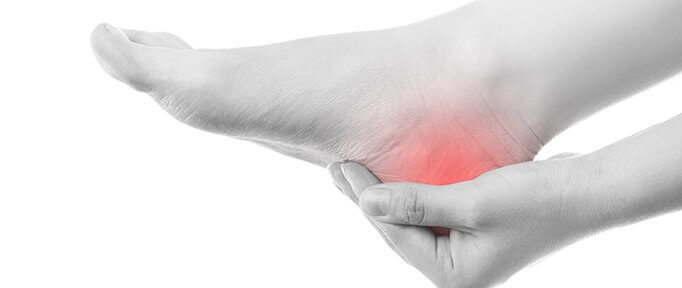Heel pain is surprisingly common in many adults and can result for a variety of reasons, however, plantar fasciitis is the most prevalent cause. It is best to have heel pain evaluated by a medical professional to determine the exact cause and best treatment options. Plantar fasciitis is named for the ligaments which connect the heel to the rest of the bones in the foot, called plantar fascia. These same ligaments support the arch of the foot, and when they become strained, plantar fasciitis occurs. The heel and foot pain is caused by these ligaments’ weakness, swelling, thickening, and inflammation. These factors can result in widespread pain over the entire foot, but pain is most often concentrated or felt first in the heel.
There are several risk factors that increase an individual’s chances of experiencing heel pain caused by plantar fasciitis. Most patients are over 35 years of age, and the condition is known to become more common after middle age. Obesity is the top risk factor, because it requires the feet’s bones and muscles to bear more weight on a regular basis. However, individuals who regularly engage in exercise that taxes the feet such as running or standing for long periods are also at risk. All of these factors cause small tears in the plantar fascia ligaments. Other types of heel pain can be caused by a similar condition known as ‘flat feet’, wherein feet lack a natural arch.
At the NY Dynamic Neuromuscular Rehabilitation Clinic, we will evaluate all the risk factors which may be contributing to an individual’s heel or foot pain. This even includes considering the type of footwear a person wears on a daily basis, as shoes with inadequate support or worn soles can lead to these conditions. When feet are regularly unsupported or vulnerable, they are more susceptible to plantar fasciitis and other ligament and muscle damage. After receiving plantar fasciitis treatment, clinicians will want to make sure the patient has properly fitting shoes. There is no need to purchase expensive footwear, just shoes that will provide adequate arch and heel support. By protecting against this risk factor in the future, patients are less likely to see a relapse caused by further damage to the plantar fascia ligaments.
Fortunately, it is possible to recover from plantar fasciitis without any necessary treatment in some cases. Once a person is aware of the risk factors and is able to rest and refrain from those activities that place undue stress on the foot ligaments, heel pain may resolve itself without any medical intervention. Prevention is often the best medicine, so the first step is always to cease activities that can aggravate the area. At the same time, most plantar fasciitis healing does require medical attention to be completely solved. This is often because it is difficult or impossible to alter one’s activities enough to make a difference. For example, it can be difficult to stop standing for long periods if one’s daily activities require it. Also, it is not always easy for someone to determine the specific cause of their pain unless there was an injury to the area. Many people wait too long, thinking that enduring the pain for a time will eventually dissipate it altogether. This only aggravates the swelling or tearing of the ligaments, which is why it is crucial to seek medical plantar fasciitis treatment as soon as possible.
The professional and caring staff of our clinic know plantar fasciitis well and can address many other causes of foot pain. Once we have identified the specific source of pain, we are able to provide a well-rounded treatment plan to reduce pain and improve overall well-being. Unlike traditional treatments from local offices, our options involve innovative solutions that go beyond masking pain symptoms to get at the root of the problem.
Every foot pain treatment option available here focuses on the regeneration of the damaged ligaments. This encourages the patient’s foot to heal while eliminating pain simultaneously. After understanding a full medical history and ordering necessary tests, the best treatment plan will be created for the specific individual. Though pain in the heel or foot can be debilitating, our clinic is confident in our experience and knowledge of treatment options available. With the right treatment solution, any type of heel condition can have a positive prognosis, and our treatments have a higher likelihood of being successful than traditional options.
There are many causes for the disease, but happily, there are also many treatment options available. With the right treatment and comprehensive healing program, we believe it is possible for every patient to have a better quality of life with less pain. Give us a call today to schedule a consultation regarding foot pain or plantar fasciitis symptoms.

























































